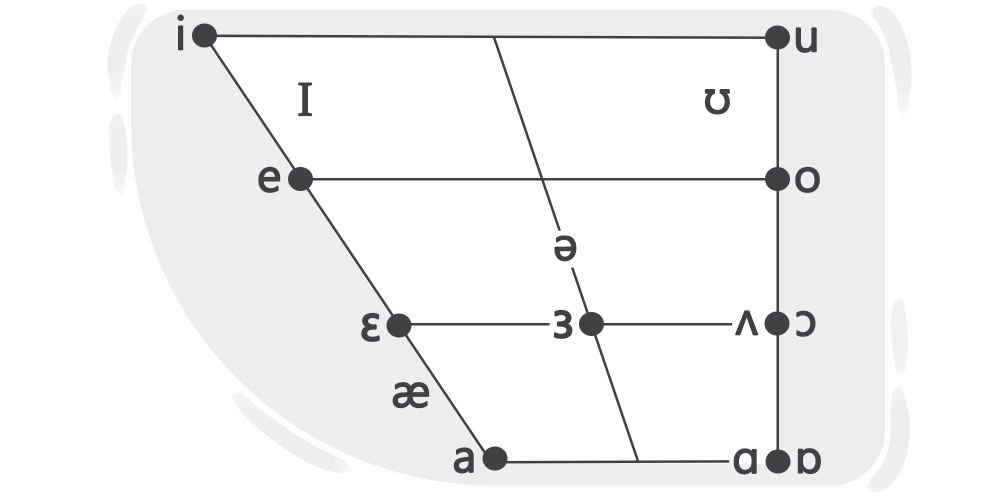Vowels In American English

What Is Vowel?
A vowel is a sound that is created by your mouth fairly open and without friction. The word 'vowel' is used for both 'vowel sounds' and also their written symbols.
English Vowel Letters
There are six vowel letters in the English Language which are mentioned below:
Tip!
Remember that each of these vowel letters does not produce the same regular sound. So to know the exact pronunciation of each word, you should check your dictionary. For example:
about /əˈbaʊt/
As you can see, the vowel letter 'a' is not pronounced as it normally sounds.
What Are The Secondary Vowel Sounds?
We have some other vowel sounds that are secondary. It is possible to distinguish between the secondary vowels by reversing the lip posture from the main vowels. Look at the table below:
Tip!
The schwa sound /ə/ is the most common sound in English that even has its own name (schwa). It is described as a weak vowel sound in an unstressed syllable and it sounds like a relaxed 'uh'. Generally, any written vowel can have the schwa sound; that's why it does not have any long version or any similar main vowel sound. For example:
today /təˈdeɪ/
As you can see, we don’t pronounce the first vowel letter as 'o', we use the weak vowel schwa.
The IPA Chart of Vowels
In the following picture, you will find the IPA vowel chart:


Diphthongs
Diphthongs are vowels that contain two different vowel sounds in one syllable. On the other hand, monophthongs are pure vowel sounds that are distinct from diphthongs. In brief, diphthongs are vowels with one vowel sound following another. Down below, there is a table of diphthongs with their examples:
Diphthongs | Examples |
|---|---|
/eɪ/ | late /leɪt/ |
/ɪə/ | fear /fɪə/ |
/eə/ | fair /feə/ |
/ʊə/ | cure /kjʊə/ |
/əʊ/ | globe /gləʊb/ |
/ɔɪ/ | coin /kɔɪn/ |
/aɪ/ | time /taɪm/ |
/aʊ/ | how /haʊ/ |
The Dimensions of Vowels
While consonants are differentiated by the manner, place, and voice of their articulation, vowels are differentiated by their position on the tongue and lips. This factor enables us to make many more vowels than the usual five vowels. In this case, there are some specific dimensions that can vary vowels:
Height (high/mid/low)
We distinguish three major degrees of height: high, mid, and low. Height shows how much the mouth must be open. The vowels /i/ and /u/ are the highest, meaning that the tongue is positioned high in the mouth. /e/ and /o/ are mid and /a/ is the lowest. For example:
machine (high vowel)
rude (high vowel)
have (low vowel)
red (mid vowel)
role (mid vowel)
Frontness and Backness
Frontness and backness show if the vowel is produced in the front of the mouth or in the back of the mouth. /i/, /ɪ/, /e/, /ɛ/, /æ/, /ʊ/ these vowels are produced in the front of the mouth, so they are front vowels and /u/, /ʌ/, /ɔ/, /ɑ/, /o/, /ɒ/ are back vowels. Note that when a vowel is produced in the center of the mouth, it is called a central vowel. The central vowels are /ə/ and /ɜ/. For example:
key → /i/
above → /ə/
Bob → /ɑ/
Tense and Lax**
The higher and less centralized vowel is referred to as tense vowel or long vowel; the lower and more centralized vowel is referred to as lax vowel or short vowel. Tense vowels are /i/, /e/, /u/, /ɔ/, /a/ and lax vowels are /ɪ/, /ɛ/, /ʊ/, /ʌ/, /æ/. Lax vowels mostly occur in one-syllable words if they end in a consonant. Take a look at some examples:
receive → /i/
As you can see, we have an example of lax vowel here.
brother → /ʌ/
Here, we have an example of tense vowel.
Rounding
There is another important difference among the vowels of English. When we articulate a letter our lips tend to form a circle. When you say /u/, your lips are rounded. When you say /i/, your lips are spread. Rounded vowels are:
/u/
/ʊ/
/o/
/ɔ/
/ɒ/
note → /o/
boot → /u/
Unrounded vowels are letters that are spelled with more relaxed lips:
/i/
/ɪ/
/e/
/ɜ/
/ɛ/
/ɑ/
/ʌ/
/ə/
fleece → /i/
cat → /æ/
Semivowels
A semivowel is a sound that is phonetically similar to a vowel sound but functions mostly as a consonant but can also act as a vowel.
Semivowels are consonants that produce a sound that is phonetically similar to a vowel sound. Semivowels in English are the consonants 'y' and 'w. Semivowels always function as the syllable boundary and are mostly used as the initial sounds.
yell
well
Comments
(0)